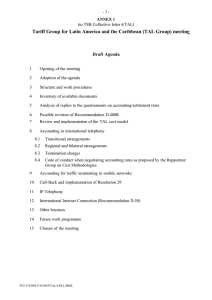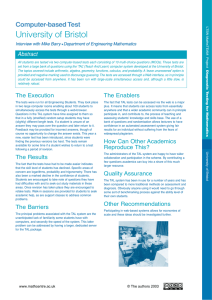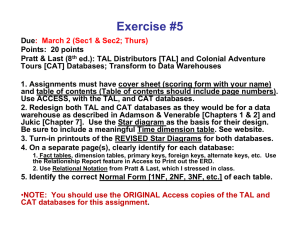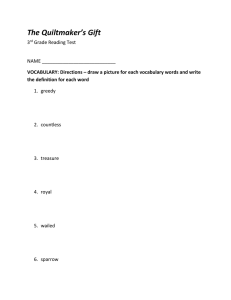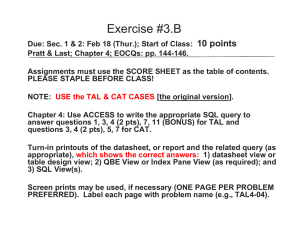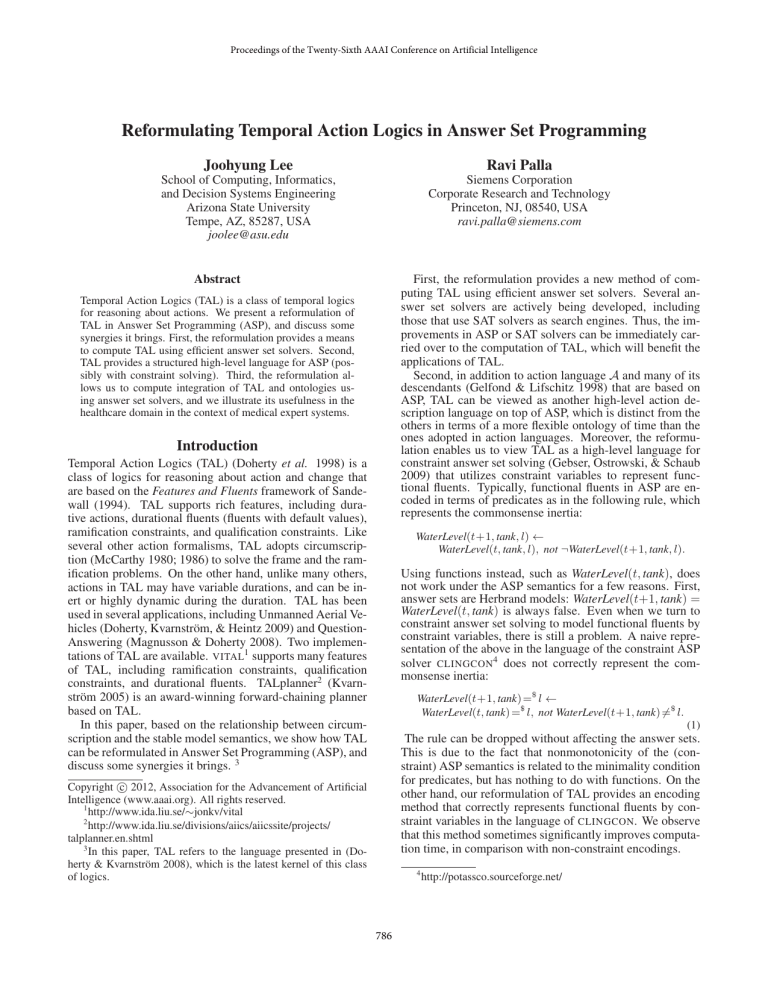
Proceedings of the Twenty-Sixth AAAI Conference on Artificial Intelligence
Reformulating Temporal Action Logics in Answer Set Programming
Joohyung Lee
Ravi Palla
School of Computing, Informatics,
and Decision Systems Engineering
Arizona State University
Tempe, AZ, 85287, USA
joolee@asu.edu
Siemens Corporation
Corporate Research and Technology
Princeton, NJ, 08540, USA
ravi.palla@siemens.com
Abstract
First, the reformulation provides a new method of computing TAL using efficient answer set solvers. Several answer set solvers are actively being developed, including
those that use SAT solvers as search engines. Thus, the improvements in ASP or SAT solvers can be immediately carried over to the computation of TAL, which will benefit the
applications of TAL.
Second, in addition to action language A and many of its
descendants (Gelfond & Lifschitz 1998) that are based on
ASP, TAL can be viewed as another high-level action description language on top of ASP, which is distinct from the
others in terms of a more flexible ontology of time than the
ones adopted in action languages. Moreover, the reformulation enables us to view TAL as a high-level language for
constraint answer set solving (Gebser, Ostrowski, & Schaub
2009) that utilizes constraint variables to represent functional fluents. Typically, functional fluents in ASP are encoded in terms of predicates as in the following rule, which
represents the commonsense inertia:
Temporal Action Logics (TAL) is a class of temporal logics
for reasoning about actions. We present a reformulation of
TAL in Answer Set Programming (ASP), and discuss some
synergies it brings. First, the reformulation provides a means
to compute TAL using efficient answer set solvers. Second,
TAL provides a structured high-level language for ASP (possibly with constraint solving). Third, the reformulation allows us to compute integration of TAL and ontologies using answer set solvers, and we illustrate its usefulness in the
healthcare domain in the context of medical expert systems.
Introduction
Temporal Action Logics (TAL) (Doherty et al. 1998) is a
class of logics for reasoning about action and change that
are based on the Features and Fluents framework of Sandewall (1994). TAL supports rich features, including durative actions, durational fluents (fluents with default values),
ramification constraints, and qualification constraints. Like
several other action formalisms, TAL adopts circumscription (McCarthy 1980; 1986) to solve the frame and the ramification problems. On the other hand, unlike many others,
actions in TAL may have variable durations, and can be inert or highly dynamic during the duration. TAL has been
used in several applications, including Unmanned Aerial Vehicles (Doherty, Kvarnström, & Heintz 2009) and QuestionAnswering (Magnusson & Doherty 2008). Two implementations of TAL are available. VITAL1 supports many features
of TAL, including ramification constraints, qualification
constraints, and durational fluents. TALplanner2 (Kvarnström 2005) is an award-winning forward-chaining planner
based on TAL.
In this paper, based on the relationship between circumscription and the stable model semantics, we show how TAL
can be reformulated in Answer Set Programming (ASP), and
discuss some synergies it brings. 3
WaterLevel(t+1, tank, l) ←
WaterLevel(t, tank, l), not ¬WaterLevel(t+1, tank, l).
Using functions instead, such as WaterLevel(t, tank), does
not work under the ASP semantics for a few reasons. First,
answer sets are Herbrand models: WaterLevel(t+1, tank) =
WaterLevel(t, tank) is always false. Even when we turn to
constraint answer set solving to model functional fluents by
constraint variables, there is still a problem. A naive representation of the above in the language of the constraint ASP
solver CLINGCON4 does not correctly represent the commonsense inertia:
WaterLevel(t+1, tank) =$ l ←
WaterLevel(t, tank) =$ l, not WaterLevel(t+1, tank) 6=$ l.
(1)
The rule can be dropped without affecting the answer sets.
This is due to the fact that nonmonotonicity of the (constraint) ASP semantics is related to the minimality condition
for predicates, but has nothing to do with functions. On the
other hand, our reformulation of TAL provides an encoding
method that correctly represents functional fluents by constraint variables in the language of CLINGCON. We observe
that this method sometimes significantly improves computation time, in comparison with non-constraint encodings.
Copyright c 2012, Association for the Advancement of Artificial
Intelligence (www.aaai.org). All rights reserved.
1
http://www.ida.liu.se/∼jonkv/vital
2
http://www.ida.liu.se/divisions/aiics/aiicssite/projects/
talplanner.en.shtml
3
In this paper, TAL refers to the language presented in (Doherty & Kvarnström 2008), which is the latest kernel of this class
of logics.
4
786
http://potassco.sourceforge.net/
Third, our reformulation can be adapted so that answer
set solvers such as DLVHEX5 can be used for computing the
integration of TAL and ontologies, thus enabling us to use
TAL in applications where there is a need to reason about
cause-effect relationships while being able to query ontologies. For example, consider a medical expert system that is
required to assist physicians in diagnosis and treatment of
diseases/disorders. There are several biomedical ontologies,
such as the Foundational Model of Anatomy (FMA) ontology6 (Rosse & Mejino 2003), the human disease ontology7 ,
and the National Drug File (NDF) ontology8 . In order to effectively assist physicians, the expert system needs to have
access to the knowledge in such ontologies. Now, consider
a patient who is suffering from gastritis and complains of
abdominal pain. The job of the system is to determine if
aspirin can be recommended to the patient. Assume that
the biomedical ontology being queried has the knowledge
that aspirin may treat pain (written in RDF for instance) and
gastrointestinal bleeding is a contraindication for administering aspirin. Further, assume that we have the knowledge
that gastritis usually causes gastrointestinal bleeding. Now,
if the system simply considers the current patient symptoms,
it will conclude that aspirin can be prescribed. However,
since gastritis usually causes gastrointestinal bleeding, this
would not be the preferred treatment. On the other hand,
if the system considers the knowledge about the effects of
gastritis, then it will be able to conclude that aspirin is not
recommended. Thus it is clear that the system needs to consider what conditions the current patient condition might
cause and then check whether any of the conditions is a contraindication to prescribing the drug. So, in addition to being
able to query ontologies, the system also needs to be able to
reason about various cause-effect relationships. This is one
of the main motivations for integrating nonmonotonic rules
and ontologies. In contrast with those approaches, that have
to integrate heterogenous semantics, TAL can be straightforwardly extended to include interfaces to ontologies. We
show how the reformulation of TAL in ASP can be used to
turn such hybrid theories into the language of DLVHEX.
substituting the variables u for the constants p. Similarly,
SM[F ; p] is defined as the second-order formula
Review: Circumscription and Stable Models
• no occurrence of a predicate constant from p is in the antecedent of more than one implication in F , and
F ∧ ¬∃u((u < p) ∧ F ∗ (u)),
where formula F ∗ (u) is defined recursively as follows:
• pi (t)∗ = ui (t) for any tuple t of terms;
• F ∗ = F for any atomic F that does not contain members
of p;
• (F
G)∗ = (F ∗
∗
∗
G∗ ),
∈ {∧, ∨};
∗
• (F → G) = (F → G ) ∧ (F → G);
• (QxF )∗ = QxF ∗ , Q ∈ {∀, ∃}.
A model of F (in the sense of first-order logic) is stable
(relative to the list p of intensional predicates) if it satisfies
SM[F ; p]. It is shown in (Ferraris, Lee, & Lifschitz 2011)
that this definition, applied to the syntax of logic programs
(by viewing them as a special case of first-order formulas)
and restricted to Herbrand models, is equivalent to the traditional definition of answer sets that is based on grounding
and fixpoint construction.
System F 2 LP (“formulas to logic programs”)9 (Lee &
Palla 2009; 2012) is a front-end that allows ASP solvers
to compute Herbrand stable models of “almost universal”
first-order theories (Lee & Palla 2012). The translation implemented in the system first eliminates quantifiers and then
turns the resulting quantifier-free formula into a logic program by flattening the nested subformulas.
Theorem 1 from (Lee & Palla 2012) tells us that for the
class of “canonical formulas,” the stable model semantics
coincides with circumscription. We say that an occurrence
of a predicate constant, or any other subexpression, in a
formula F is strictly positive if it is not contained in the
antecedent of any implication. For example, in formula
∀x(¬p(x) → q(x)), the occurrence of q is strictly positive
(we view ¬p(x) as shorthand for p(x) → ⊥).
We say that a formula F is canonical relative to a list p of
predicate constants if
We follow the definition of a stable model from (Ferraris,
Lee, & Lifschitz 2011). There, stable models are defined using the “stable model operator SM” with “intensional predicates,” similar to circumscription.
Let p be a list of distinct predicate constants p1 , . . . , pn
other than equality.
For any first-order formula F ,
CIRC[F ; p] is defined as the second-order formula
• every occurrence of a predicate constant from p that is in
the scope of a strictly positive occurrence of ∃ or ∨ in F
is strictly positive in F .
For example, formula ∀x(¬p(x) → q(x)) is not canonical
relative to {p, q} since it does not satisfy the first clause of
the definition. On the other hand, the formula is canonical
relative to {q}. Formula p(a, a) ∧ ∃x(p(x, a) → p(b, x)) is
not canonical relative to {p, q} since it does not satisfy the
second clause.
The following theorem states that, for any canonical formula, circumscription coincides with the stable model semantics. In other words, stable models and minimal models
coincide on canonical formulas. This result will be used to
reformulate TAL in ASP.
F ∧ ¬∃u((u < p) ∧ F (u)),
where u is a list of distinct predicate variables of the same
length as p, expression u < p stands for a formula expressing that u is “stronger than” p, as defined in (Lifschitz 1994), and F (u) is the formula obtained from F by
5
http://www.kr.tuwien.ac.at/research/systems/dlvhex/
http://sig.biostr.washington.edu/projects/fm/
7
http://www.obofoundry.org/
8
http://bioportal.bioontology.org/ontologies/40402
6
9
787
http://reasoning.eas.asu.edu/f2lp
Theorem 1 (Lee & Palla 2012, Theorem 1) For any canonical formula F relative to p,
time structure. The language uses the ternary predicates
Holds and Occurs, and the binary predicate Occlude. The
translation from L(ND) to L(FL) is given by the function Trans (Doherty & Kvarnström 2008). For instance,
Trans([t]f =ω)
ˆ
is defined as Holds(t, f, ω) (fluent f has
value ω at time t). Similarly, Trans(R((t, t0 ]f =ω))
ˆ
is defined as
CIRC[F ; p] ↔ SM[F ; p]
is logically valid.
Reformulating TAL in ASP
∀t00 (t < t00 ≤ t0 → Occlude(t00 , f )) ∧ Holds(t0 , f, ω).
Review: Temporal Action Logics
Due to lack of space, we refer the reader to (Doherty et al.
1998; Doherty & Kvarnström 2008) for the details about the
syntax and the semantics of TAL.
In TAL, a scenario (or narrative) can be described in
a compact surface language L(ND), which is a high-level
macro expandable language consisting of action type specifications (acs), dependency constraints (dep), domain constraints (dom), persistence statements (per), observation
statements (obs), and action occurrence statements (occ).
Consider the Russian Airplane Hijack (RAH) scenario (Doherty et al. 1998; Doherty & Kvarnström 2008), in which
some businessmen try to board a plane while carrying certain items in their pockets. This example demonstrates the
capability of TAL in handling the ramification and qualification problems. We only show the action type specifications for the actions Put and Board, and some dependency
constraints. The fluent PossBoard(person, airplane) is durational with default value true, and the rest of the fluents
are persistent (inertial). The direct effects of actions Put and
Board are represented by the following action type specifications:
Occlude(t, f ) represents that a persistent or durational fluent
f is exempt from inertia or default value assumption, respectively, at time t. Trans([t, t0 ]Ψ), where Ψ is an action term,
is defined as Occurs(t, t0 , Ψ), which represents that action Ψ
occurs in the interval [t, t0 ]. Following is a representation of
acs1 in the language L(FL):
Occurs(t1 , t2 , Put(person, pthing, pocket)) →
∃loc (Holds(t1 , Loc(person), loc)∧
Holds(t1 , Loc(pthing), loc)) →
∀t (t1 < t ≤ t2 →
Occlude(t, InPocket(person, pthing)))∧
Holds(t2 , InPocket(person, pthing), true) .
(2)
Consider any narrative N and let Nper , Nobs , Nocc , Nacs ,
Ndomc , and Ndepc denote the sets of persistence statements,
observation statements, action occurrence statements, action type specifications, domain constraints, and dependency
constraints in N respectively. The TAL domain description
(referred to as preferred narrative) ∆N is given by
CIRC[Γocc ; Occurs] ∧ CIRC[Γdepc ∧ Γacs ; Occlude] ∧
∧ Γf nd ∧ Γtime ∧ Γper ∧ Γobs ∧ Γdomc ,
acs1 [t1 , t2 ]Put(person, pthing, pocket)
→ ([t1 ] Loc(person)=Loc(pthing)
ˆ
→ R((t1, t2] InPocket(person, pthing))).
acs2 [t1 , t2 ]Board(person, airplane) →
[t1 ] PossBoard(person, airplane)∧
Loc(person)=Airport
ˆ
→
R([t2 ] Loc(person)=Loc(airplane)∧
ˆ
OnPlane(airplane, person)) .
(3)
where Γper , Γobs , Γocc , Γacs , Γdomc , and Γdepc are the
formulas in L(FL) (first-order logic formulas) obtained by
applying Trans on Nper , Nobs , Nocc , Nacs , Ndomc , and
Ndepc respectively; Γf nd is the set of foundational axioms
in L(FL), containing unique name axioms, unique value axioms, etc., and Γtime is the axiomatization of the particular
temporal structure used in TAL.
Reformulating Temporal Action Logics in Answer
Set Programming
(The R operator is used for reassignment, and ensures that
the formula holds at the final timepoint in the interval.) The
first statement above represents that if a person puts a thing
into his/her pocket in the time interval [t1 , t2 ] and if the location of the person is the same as the location of the thing
at t1 , then InPocket is released from inertia in the interval
(t1 , t2 ] and the thing is in the pocket at timepoint t2 (i.e.,
InPocket(person, pthing) becomes true at t2 ). The second
statement is similar. One of the qualification constraints for
the action Board is as follows:
To reformulate TAL in ASP, we first reformulate TAL in the
first-order stable model semantics and then use F 2 LP to turn
the resulting theory into ASP. The following theorem shows
how TAL can be reformulated in the first-order stable model
semantics. In the following, we use Γncirc to denote the
formula Γf nd ∧ Γtime ∧ Γper ∧ Γobs ∧ Γdomc .
Fact 1 The following facts are easy to check from the syntax
of TAL:
• Γocc is canonical relative to Occurs;
• Γdepc ∧ Γacs is canonical relative to Occlude.
dep1 [t]InPocket(person, gun)
→ I([t] ∀airplane(¬PossBoard(person, airplane))).
(The I operator is used for interval reassignment, and ensures that the formula holds during the entire interval.) This
dependency constraint represents that if a person has a gun
in his/her pocket, then he/she is not able to board any airplane.
Reasoning about a narrative in L(ND) is done by translating it into the base language L(FL), which is an ordersorted classical first-order language using a linear, discrete
The following theorem shows a reformulation of TAL in
the first-order stable model semantics.
Theorem 2 For any TAL domain description (3), the following formulas are equivalent to each other:
(a) CIRC[Γocc ; Occurs] ∧ CIRC[Γdepc ∧ Γacs ; Occlude] ∧
Γncirc
788
(b) SM[Γocc ; Occurs] ∧ SM[Γdepc ∧ Γacs ; Occlude] ∧ Γncirc
(c) SM[Γocc ∧ Γdepc ∧ Γacs ∧ Γncirc ; Occurs, Occlude] .
The equivalence between (a) and (b) follows from Theorem 1 and Fact 1. The equivalence between (b) and (c) follows from the splitting theorem from (Ferraris et al. 2009).
Formula
Γocc ∧ Γdepc ∧ Γacs ∧ Γncirc
For example, consider the persistence statement
per ∀t Per(t, WaterLevel(tank))
which represents that WaterLevel(tank) is an inertial fluent.
This is represented in L(FL) as follows:
¬Occlude(t+1, WaterLevel(tank))
→ ∀v (Holds(t+1, WaterLevel(tank), v) ↔ Holds(t, WaterLevel(tank), v)) .
(4)
inside SM in (c) can be represented in the language of F 2 LP.
For instance, formula (2) can be represented in the language
of F 2 LP as follows:
In view of Theorem 3, this can be represented as
¬Occlude(t+1, WaterLevel(tank)) →
Val(t+1, WaterLevel(tank)) = Val(t, WaterLevel(tank)).
occurs(T1,T2,put(Pe, Pt, Po)) ->
(?[Lo]:(holds(T1,loc(Pe),Lo) & holds(T1,loc(Pt),Lo))
-> (![T]:(T > T1 & T <= T2 ->
occlude(T,inpocket(Pe,Pt))) &
holds(T2,inpocket(Pe,Pt),true))).
or in the language of CLINGCON as
val(T+1,waterLevel(Tank)) $== val(T,waterLevel(Tank))
:- not occlude(T+1, waterLevel(Tank)).
The translation implemented in F 2 LP turns the formula (4)
into a logic program (in the input language of GRINGO),
whose stable models are identical to the models of the formula in (c) when we disregard new atoms introduced in the
translation. The ability to write complex formulas in the language of F 2 LP greatly facilitates encoding efforts for TAL.
The following command can be used for computing the
answer sets of the (complete) theory encoded in the file
RAH.f2lp ([N] has to be substituted with an appropriate
value representing the maximum timepoint of interest):
In comparison with the rule (1), this example illustrates that
the TAL style encoding allows us to represent the commonsense inertia correctly in the language of CLINGCON. Our
experiments in the next section indicate that it is also computationally advantageous when fluents range over large numeric domains.
Experimental Evaluation
VITAL (“Visualization and Implementation of Temporal Action Logics”) is a tool for reasoning about actions using
TAL. The tool supports rich features in TAL, including ramification constraints, qualification constraints, and durational
fluents. It not only generates the models but also provides a
visualization of the models, which makes it easier to verify
the output and is also useful in developing TAL narratives.
The primary focus in the design of the tool was on supporting a high degree of expressivity in TAL, rather than on raw
performance.13
We compare the performance of VITAL and our ASPbased method on three scenarios. The TAL descriptions of
the Russian Airplane Hijack (RAH) and the Water Tank scenarios are provided with the VITAL distribution; we encoded
a TAL description of the Zoo World, a medium size action
domain proposed by Sandewall (Akman et al. 2004). All experiments were done on a Pentium machine with 3.06 GHz
CPU and 4GB RAM running 64-bit Linux.
Figure 1 shows the comparison of VITAL (v.2.999.910 alpha) with the following tools for the RAH and Water Tank
scenarios in language L(FL):
$ f2lp RAH.f2lp | gringo -c maxstep=[N] | claspD
TAL in Constraint ASP
The translation Trans represents functional fluents using
predicates. That is, it turns formulas of the form [t] f =ω
ˆ
into Holds(t, f, ω). This may cause a grounding bottleneck for non-Boolean domains in our ASP-based computation. Here we present how to avoid this problem by representing functional fluents by constraint variables in the
language of CLINGCON, a system that combines the ASP
solver CLINGO10 and the CP (Constraint Processing) solver
GECODE 11 .
Intuitively, since Holds is non-intensional, we can simply
replace Holds(t1 , f (x1 ), v1 ) in (4) with Val(t1 , f (x1 )) =
v1 , where Val is a new function constant. We make the idea
precise as follows. Consider a TAL narrative N and any
subset S of the set of feature symbols12 in N . If F is formula (4), by FS we denote the formula obtained from F by
replacing every occurrence of Holds(t1 , f (x1 ), v1 ), where
f ∈ S, with Val(t1 , f (x1 )) = v1 .
Theorem 3 Let N be a TAL narrative, let ∆N be the corresponding preferred narrative (3), and let F be the formula (4). Under the assumption
∀t, x, v(Holds(t, f (x), v) ↔ Val(t, f (x)) = v)
for every feature symbol f in a set S of feature symbols, SM[F ; Occurs, Occlude] is equivalent to
SM[FS ; Occurs, Occlude].
•
F 2 LP (v 1.11) with GRINGO (v 3.0.3) + CLASP (v 2.0.2),14
•
F 2 LP (v 1.11) with CLINGCON (v 0.1.2) ( GRINGO v 2.0.2
and CLASP v 1.1.1) , and
•
F 2 LP (v 1.11) with GRINGO (v 3.0.3) +
(v 3.79) running MINISAT16 (v 2.0 beta).
13
CMODELS 15
This information was provided to us by Jonas Kvarnström in a
personal communication.
14
http://potassco.sourceforge.net/
15
http://www.cs.utexas.edu/ tag/cmodels/
16
http://minisat.se/
10
http://potassco.sourceforge.net/
http://www.gecode.org/
12
The feature symbol corresponding to a fluent f (x) is f .
11
789
Problem
(max. step)
VITAL
F 2 LP with
GRINGO + CMODELS
F 2 LP with
GRINGO + CLASP
RAH-proj
(16)
RAH-proj
(50)
RAH-plan-unit
(7)
RAH-plan-unit
(10)
RAH-plan-dur
(6)
RAH-plan-dur
(9)
WaterTank-proj100 (16)
WaterTank-proj200 (25)
WaterTank-proj300 (30)
0.01s
0.23s
(0.08s + 0.15s)
0.99s
(0.32s + 0.67s)
0.13s
(0.03s + 0.1s)
0.45s
(0.1s + 0.35s)
0.3s
(0.07s + 0.23s)
0.66s
(0.13s + 0.53s)
> 30min
[0.06s]
> 30min
[0.14s]
> 30min
[0.22s]
0.13s
(0.08s + 0.05s)
0.53s
(0.32s + 0.21s)
0.08s
(0.03s + 0.05s)
0.29s
(0.1s + 0.19s)
0.11s
(0.07s + 0.04s)
0.26s
(0.13s + 0.13s)
> 30min
[0.05s]
> 30min
[0.13s]
> 30min
[0.21s]
0.05s
10.56s
> 30min
540.59s
> 30min
0.07s
0.03s
0.01s
F 2 LP with
CLINGCON
0.1s
0.35s
0.07s
0.23s
0.1s
0.33s
Problem
(max. step)
VITAL
F 2 LP with
GRINGO + CMODELS
F 2 LP with
GRINGO + CLASP
F 2 LP with
CLINGCON
ZooWorld-proj
(20)
ZooWorld-proj
(50)
ZooWorld-post
(15)
ZooWorld-post
(15)
ZooWorld-post
(20)
0.43s
0.97s
(0.39s + 0.58s)
4.85s
(2.28s + 2.57s)
0.62s
(0.24s + 0.38s)
0.59s
(0.24s + 0.25s)
0.99s
(0.41s + 0.58s)
0.80s
(0.39s + 0.41s)
4.33s
(2.28s + 2.05s)
0.51s
(0.24s + 0.27s)
0.51s
(0.24s + 0.27s)
0.82s
(0.41s + 0.41s)
0.49s
> 30min
61.63s
17.40s
477.4s
2.03s
0.33s
0.33s
0.5s
8.92s
Figure 2:
119.44s
VITAL
vs. F 2 LP + ASP solvers in the Zoo World
591.15s
As we can see from the results, VITAL performed quite
well on (almost all of) the projection problems but is not
very efficient on the planning and postdiction problems we
considered. On the other hand, our ASP-based approach performed equally well on all the problems, except on those involving numeric domains, such as the Water Tank scenario.
The results also clearly show the advantage of turning TAL
into the language of CLINGCON for handling large numeric
domains.
We also compared the performance of our method with
TALplanner. Detailed results are not shown here since the
version of TALplanner we obtained from the developer has
several features disabled. Thus, the performance of this version is not indicative of what the planner is actually capable of. Further, the performance of TALplanner heavily depends on the quality of control rules used, while ASP-based
planning typically does not make use of control rules but
works with reasonable efficiency. Also, the main search
method of TALplanner is depth-first search, which provides
no guarantee of optimality. Having said that, the experiment
showed that TALplanner was considerably faster than our
ASP-based method for planning tasks. On the other hand,
the plans generated by TALplanner were often much longer
than the minimal length plans generated by our ASP-based
method.
Figure 1: Comparison of VITAL with F 2 LP + ASP solvers
The times shown in the parentheses are “(grounding time
+ solving time).” The cut-off time we used for the tools to
terminate and return one model is 30 minutes.
For the RAH scenario, the first two problems are projection problems and the next four are planning problems.
Among the planning problems, the first two consider all actions to be of unit duration, and the next two consider actions
with fixed lower and upper bounds on their durations. For
each planning problem, “max.step” is also the minimal
length of the plan found. While VITAL is in general not as
efficient as TALplanner on planning problems, it allows us
to represent domains, such as the RAH scenario, which involve ramification and qualification constraints, that are not
allowed in TALplanner. For the Water Tank scenario, the
number in the problem name is the maximum value in the
domain of the numbers considered. For instance, the number domain used for “WaterTank-proj-100” is 0..100. The
times reported in square brackets is when we removed the
unique value axioms (“a fluent has exactly one value at each
timepoint”), and instead added axioms that uniquely define
the value of each fluent at every timepoint. Such rewriting
works for this particular scenario, and drastically improves
the performance. For example,
Hybrid Temporal Action Logic Theories
Description logics form a basis of the Web Ontology Language (OWL). We consider how to integrate TAL with description logic based ontologies. Since both of them are
based on classical logic, the integration is straightforward.
% unique value axiom
1{holds(T,waterlev(Tank),Number):num(Number)}1.
% constraint for determining next water level
-(holds(T,waterlev(Tank),Nu1)
& holds(T,inflow(Tank),Nu2)
& ...
& -holds(T+1,waterlev(Tank),Nu4)).
Definition 1 Let ΣΓ and ΣT be signatures which agree on
common constants. A hybrid action theory (Γ, T ), where
Γ is a TAL domain description of signature ΣΓ and T is
a description logic knowledge base of signature ΣT , is the
conjunction Γ∧FO(T ) of signature ΣΓ ∪ΣT , where FO(T )
is the first-order logic representation of T .
Consider the example discussed in the introduction. Following is a partial TAL description of the domain in the surface language. Admin(d) represents the action of drug d being administered. For simplicity, the duration of the action
is assumed to be equal to the time taken for the effects of the
drug to wear off. Fluent Condition(c) is used to represent
if the patient is currently suffering from disease/disorder c,
and fluent SideEffect(d) is used to represent if the drug d
has a side-effect on the patient. The predicates in all capitals
(MAY TREAT, MAY PREVENT, and CONTRAINDICATION) are
can be turned into
(holds(T,waterlev(Tank),Nu1)
& holds(T,inflow(Tank),Nu2)
& ...
-> holds(T+1,waterlev(Tank),Nu4)).
As the results show, this simple modification has a significant impact on the times taken by GRINGO + CLASP and
GRINGO + CMODELS in returning an answer set.
Figure 2 shows the comparison with VITAL for the Zoo
World scenario. The first two are projection problems, and
the remaining are postdiction problems.
790
description logic predicates (properties in the ontologies),
and are time-independent. MAY TREAT(d, c) represents that
drug d may treat c, MAY PREVENT(d, c) represents that drug
d may prevent c, and CONTRAINDICATION(d, c) represents
that c is a contraindication for administering drug d. The
fluents Ab1 and Ab2 are used to represent the abnormalities,
and these are treated as durational fluents with default value
false. The other fluents are persistent.
resented in OWL: the NDF ontology (NDF-RT2 public edition), which contains knowledge about drugs (i.e., what they
may treat, prevent, the contraindications for the drugs, etc.),
and the human disease ontology (alpha version), which contains knowledge about human diseases (such as definitions
of the diseases, synonyms of the diseases, etc.). The NDF
ontology has over 40,000 classes and the human disease ontology has over 8000 classes.
We encode the TAL description in F 2 LP and use
the rdf plugin for DLVHEX to generate the relevant instances of the Description Logic atoms MAY TREAT(d, c),
MAY PREVENT(d, c), and CONTRAINDICATION(d, c). Since
F 2 LP only outputs programs in the language of GRINGO and
LPARSE , we implemented a python program f2lpdlv.py
to turn the output of F 2 LP into the language of DLV17 . Also,
since DLVHEX (v.1.7.2) does not allow functions, we flatten atoms (e.g., holds(T, condition(C), V) is turned into
holds(T, condition, C, V)).
For the above example, we add the following observations
and query:
acs1 [t1 , t2 ] Admin(d) →
[t1 ] Condition(c) ∧ ¬Ab1 (d, c)∧
(MAY TREAT(d, c) ∨ MAY PREVENT(d, c))∧
¬∃c1 , t t1 ≤ t ≤ t2 ∧ [t] Condition(c1 )∧
CONTRAINDICATION(d, c1 ) → I((t1 , t2 ] ¬Condition(c)) .
acs2 [t1 , t2 ] Admin(d) →
∀t t1 ≤ t ≤ t2 ∧
[t]∃c(Condition(c) ∧ CONTRAINDICATION(d, c))
→ I([t, t2 ] SideEffect(d)) .
dep1 ∀t([t] Condition(Gastritis) ∧ ¬Ab2 (Gastritis) →
R([t + 1] Condition(GastrointestinalBleeding))).
%initial state
gastritisId(X) -> holds(0,condition,X,true).
painId(X) -> holds(0,condition,X,true).
giBleedingId(X) -> holds(0,condition,X,false).
drug(D) -> holds(0,sideEffect,D,false).
The first statement represents that if no contraindication
to the drug d holds in the interval [t1 , t2 ], then administering
d, which may treat or may prevent c, usually has a positive effect on the patient who is suffering from c. The second statement represents that if a contraindication to drug
d holds in the interval [t1 , t2 ], then administering d in that
interval causes a side-effect. Finally, the dependency constraint represents that gastritis usually causes gastroinstestinal bleeding. This example shows the usefulness of the durative actions and dependency constraints available in TAL.
Given that Condition(Gastritis) and Condition(Pain)
hold at timepoint 0, and the ontology being queried
entails
the
facts
MAY TREAT(Aspirin, Pain)
and
CONTRAINDICATION(Aspirin, GastrointestinalBleeding),
one can verify the following from the above description:
% query: can aspirin be given to the patient?
aspirinId(X) -> occurs(0,2,admin,X).
painId(C) & aspirinId(X) ->
-(holds(2,condition,C,false) &
-?[T]: (T >=0 & T <=2 &
holds(T,sideEffect,X,true))).
The predicates ending with Id represent the class names
(in the NDF) of the corresponding drug or condition. For instance, the extent of painId contains just one element and
that element is the class name of the class with label Pain.
The first formula following the initial state description represents that Aspirin is administered in the interval [0, 2], and
the second formula is the negation of the query we want to
check. The query here is to check if administering Aspirin
treats the pain such that no side-effect is caused in the interval [0, 2].
Following is a part of an answer set produced when the
maximum timepoint is set to 2 (the existence of an answer
set indicates that the query is not entailed):
• Condition(GastrointestinalBleeding) is true for all timepoints τ ≥ 1;
• if Admin(Aspirin) occurs in the interval [0, 2], then
SideEffect(Aspirin) is true for all timepoints τ ≥ 1.
Thus, the system will conclude that Aspirin is not recommended.
Now, consider an initial state in which only
Condition(Pain) is true and the rest of the fluents are false.
Further, assume that neither
Condition(GastrointestinalBleeding) nor any other contraindication to administering aspirin is caused in some
interval [τ1 , τ2 ]. If Admin(Aspirin) occurs in the interval
[τ1 , τ2 ], then Condition(Pain) is false for all τ > τ1 and
no side-effect will be caused. So, the system will be able
to conclude that Aspirin can be recommended, unless a
contraindication to it may be caused in the interval that it is
to be administered.
{holds(0,condition,"<NDF#N0000001314>",true),
holds(0,condition,"<NDF#N0000002278>",true),
holds(1,condition,"<NDF#N0000001482>",true),
holds(1,condition,"<NDF#N0000001314>",true),
holds(1,condition,"<NDF#N0000002278>",true),
holds(1,sideEffect,"<NDF#N0000145918>",true),
holds(2,condition,"<NDF#N0000001482>",true),
holds(2,condition,"<NDF#N0000001314>",true),
holds(2,condition,"<NDF#N0000002278>",true),
holds(2,sideEffect,"<NDF#N0000145918>",true)}
Using DLVHEX to Compute Hybrid Theories
Here, N0000001314, N0000002278, N0000001482, and
N0000145918 are the class names corresponding to
We use the answer set solver DLVHEX for reasoning about
hybrid theories as it allows for integrating with external ontologies. In our experiments, we use two ontologies rep-
17
791
http://www.dlvsystem.com/
Gastritis, Pain, Gastroinstestinal Bleeding, and Aspirin respectively. Also, NDF is an abbreviation for the namespace
of the ontology. This output indicates that a side-effect is
caused at timepoint 1 and that administering aspirin in the
interval [0, 2] does not relieve pain. Running the same query
with the drug acetaminophen instead of aspirin produces no
answer set, which indicates that acetaminophen can be recommended.
We also tested some other examples, details of which are
available on the F 2 LP webpage.
Ferraris, P.; Lee, J.; and Lifschitz, V. 2011. Stable models
and circumscription. Artificial Intelligence 175:236–263.
Gebser, M.; Ostrowski, M.; and Schaub, T. 2009. Constraint answer set solving. In Proceedings of International
Conference on Logic Programming (ICLP), 235–249.
Gelfond, M., and Lifschitz, V. 1998. Action languages19 .
Electronic Transactions on Artificial Intelligence 3:195–
210.
Kim, T.-W.; Lee, J.; and Palla, R. 2009. Circumscriptive
event calculus as answer set programming. In Proceedings
of International Joint Conference on Artificial Intelligence
(IJCAI), 823–829.
Kvarnström, J. 2005. TALplanner and other extensions to
temporal action logic. PhD thesis, Linköping University,
Linköping Studies in Science and Technology, Dissertation
No. 937.
Lee, J., and Palla, R. 2009. System F 2 LP – computing answer sets of first-order formulas. In Procedings of International Conference on Logic Programming and Nonmonotonic Reasoning (LPNMR), 515–521.
Lee, J., and Palla, R. 2010. Situation calculus as answer set
programming. In Proceedings of the AAAI Conference on
Artificial Intelligence (AAAI), 309–314.
Lee, J., and Palla, R. 2012. Reformulating the situation
calculus and the event calculus in the general theory of stable
models and in answer set programming. Journal of Artificial
Inteligence Research (JAIR) To appear.
Lifschitz, V. 1994. Circumscription. In Gabbay, D.; Hogger, C.; and Robinson, J., eds., Handbook of Logic in AI and
Logic Programming, volume 3. Oxford University Press.
298–352.
Magnusson, M., and Doherty, P. 2008. Temporal action
logic for question answering in an adventure game. In
In Proc. 1st Artificial Game Intelligence (AGI) Conference,
236–247.
McCarthy, J. 1980. Circumscription—a form of non-monotonic reasoning. Artificial Intelligence 13:27–39,171–172.
McCarthy, J. 1986. Applications of circumscription to formalizing common sense knowledge. Artificial Intelligence
26(3):89–116.
Rosse, C., and Mejino, J. L. V. 2003. A reference ontology for biomedical informatics: the foundational model of
anatomy. Journal of Biomedical Informatics 36(6):478–500.
Sandewall, E. 1994. Features and Fluents, volume 1. Oxford University Press.
Conclusion
Our reformulation of TAL in ASP is based on the same idea
as the reformulations of the event calculus and the situation
calculus in ASP (Kim, Lee, & Palla 2009; Lee & Palla 2010;
2012). On the other hand, it is distinct from the earlier
work as it shows that functional fluents in TAL can be represented by constraint variables in constraint answer set solving. Also, it shows that an answer set solver like DLVHEX
can be used for computing the integration of TAL with ontologies, thereby allowing expressive reasoning about dynamic systems while also being able to query ontologies.
We expect that the techniques developed in this paper can
be applied to other action calculi as well.
Acknowledgements
We are grateful to Jonas Kvarnström for his help on using VITAL and TALPlanner, and for answering our related
questions. We are also grateful to the anonymous referees
for their useful comments. This research was partially supported by the National Science Foundation under Grant IIS0916116 and by Siemens Corporate Research. The work
was done when the second author was at Arizona State University.
References
Akman, V.; Erdoğan, S.; Lee, J.; Lifschitz, V.; and Turner,
H. 2004. Representing the Zoo World and the Traffic World
in the language of the Causal Calculator. Artificial Intelligence 153(1–2):105–140.
Doherty, P., and Kvarnström, J. 2008. Temporal action logics. In van Harmelen, F.; Lifschitz, V.; and Porter, B., eds.,
Handbook of Knowledge Representation. Elsevier Science.
709–757.
Doherty, P.; Gustafsson, J.; Karlsson, L.; and Kvarnström, J.
1998. TAL: Temporal action logics language specification
and tutorial18 . Linköping Electronic Articles in Computer
and Information Science ISSN 1401-9841 3(015).
Doherty, P.; Kvarnström, J.; and Heintz, F. 2009. A temporal logic-based planning and execution monitoring framework for unmanned aircraft systems. Autonomous Agents
and Multi-Agent Systems 19(3):332–377.
Ferraris, P.; Lee, J.; Lifschitz, V.; and Palla, R. 2009. Symmetric splitting in the general theory of stable models. In
Proceedings of International Joint Conference on Artificial
Intelligence (IJCAI), 797–803.
18
19
http://www.ep.liu.se/ea/cis/1998/015/
792
http://www.ep.liu.se/ea/cis/1998/016/

